Lightweight Concrete Containing Phase Change Materials (PCMs): A Numerical Investigation on the Thermal Behaviour of Cladding Panels
Abstract
:1. Introduction
2. Lightweight Concrete with Embedded PCMs
2.1. Concept and Methodology
2.2. PCMs in Cladding
2.3. Multilayer Panels
3. Numerical Modelling
- The heat transfer between the external layer of the panel and the outside environment takes place by convection and by radiation;
- The heat transfer inside the panel takes place by conduction, and can be modelled as one-dimensional;
- The layers of the panel consist of homogeneous and isotropic materials;
- The density and conductivity are constant with temperature;
- The specific heat is constant with temperature, since the latent heat due to the phase transition of the PCM is considered separately (explicit model);
- The contact thermal resistance between the layers is negligible: as a consequence, both the temperature and the heat flux are continuous inside the panel;
- The behaviour of the external and internal layers is fully reversible.
3.1. Boundary Conditions
- q is the thermal flux per unit surface (W/m);
- h is the convection coefficient ((W/(m·°C));
- is the ambient temperature (either outside or inside);
- is the temperature of the surface in contact with the ambient ( or , respectively, in Figure 2).
- = 8.3 W/(m ·°C) = 29,880 J/(h·m·°C)
- = 17 W/(m ·°C) = 61,200 J/(h·m·°C)
3.2. Materials Properties
- density (kg/m)
- conductivity (W/(m·°C))
- specific heat c (J/kg)
- NSC: normal-strength concrete, with standard values of density and specific heat; as for the conductivity, its value was determined as the average between the two extreme values proposed in EN 1992-1-2 at 0 °C;
- Insulation: the values of the conductivity and specific heat are standard values commonly found in the literature [12]; the density value allows for the water absorbed during the casting process;
- LWC600: light-weight concrete, with density = 600 kg/m; the value of the specific heat was taken from EN 1994-1-2, whereas the conductivity was evaluated in accordance with [34], taking into consideration that conductivity decreases as the density decreases;
- LWC1200: light-weight concrete, with a density = 1200 kg/m; the values of specific heat and conductivity were evaluated as for LWC600.
4. Results and Comments
5. Concluding Remarks
- The addition of PCMs to the internal and external concrete layers of sandwich panels is beneficial, for both temperature–time scenarios and type of panel, with energy savings that can be as high as 20% in Panel 2 (characterized by a higher thermal resistance);
- PCMs also cause a significant reduction (−39%) in the peak energy required for heating and cooling;
- For the two temperature-time scenarios considered, the effect of PCMs appears to be relatively more significant in the hot season, when energy is required for cooling;
- With regards the two types of panel investigated, the effect of PCMs is relatively more significant in Panel 2, where the intermediate layer consisting of insulation leads to a lower value of thermal transmittance, therefore to overall lower values of the heat flux and of the resulting total energy;
- Despite the fact that adding PCMs is always beneficial, it can in no way overcome poor thermal behaviour (as is the case for Panel 1, where no insulation is present in the intermediate layer).
Acknowledgments
Author Contributions
Conflicts of Interest
Abbreviations
| DCA | Decanoic capric acid |
| EU | European Union |
| FAs | Fatty acids |
| G | Glycerine |
| LCA | Life cycle analysis |
| LTE | Latent thermal energy |
| LWAs | Lightweight aggregates |
| LWC | Light-weight concrete |
| NSC | Normal-strength concrete |
| OCA | Octanoic capric acid |
| PCMs | Phase change materials |
| e-PCM | Micro-encapsulated-PCM |
| PTt | Phase transition temperature |
| ss-PCM | Shape-stabilised-PCM |
| STE | Sensible thermal energy |
| TES | Thermal energy storage |
References
- European Commission. Energy-Efficient Buildings; European Commission Directorate-General for Research Innovation: Brussels, Belgium, 2013. [Google Scholar]
- Salyer, I.O.; Sircar, A.K. Development of PCM wallboard for heating and cooling of residential buildings. In U.S. Department of Energy—Thermal Energy Storage Research Activities Review; U.S. Department of Energy: Washington, DC, USA, 1989; pp. 97–123. [Google Scholar]
- Pielichowska, K.; Pielichowski, K. Phase change materials for thermal energy storage. Prog. Mater. Sci. 2014, 65, 67–123. [Google Scholar] [CrossRef]
- Baldassarri, C.; Sala, S.; Lamperti, M.; Caverzan, A. Impact Evaluation of PCMs Applications in EU28; Technical Report JRC 99785, JRC Technical Reports; European Commission: Ispra, Italy, 2015. [Google Scholar]
- Caverzan, A.; Lamperti Tornaghi, M. Innovative PCMs Applications in Buildings; Technical Report JRC 97504, JRC Technical Reports; European Commission: Ispra, Italy, 2015. [Google Scholar]
- Castell, A.; Menoufi, K.; de Gracia, A.; Rincón, L.; Boer, D.; Cabeza, L.F. Life Cycle Assessment of alveolar brick construction system incorporating phase change materials (PCMs). Appl. Energy 2013, 101, 600–608. [Google Scholar] [CrossRef]
- Thiele, A.M.; Sant, G.; Pilon, L. Diurnal thermal analysis of microencapsulated PCM-concrete composite walls. Energy Convers. Manag. 2015, 93, 215–227. [Google Scholar] [CrossRef]
- Poudel, N.; Blouin, V.Y. US Map Visualization of Optimal Properties of Phase Change Materials for Building Efficiency. Available online: http://www.arcc-journal.org/index.php/repository/article/view/217 (accessed on 18 April 2017).
- Zhang, D.; Li, Z.; Zhou, J.; Wu, K. Development of thermal energy storage concrete. Cem. Concr. Res. 2004, 34, 927–934. [Google Scholar] [CrossRef]
- Collins, M.P.; Mitchell, D. Prestressed Concrete Structures; Response Publications: Toronto and Montreal, Canada, 1991. [Google Scholar]
- Niall, D.; West, R.P.; McCormack, S. Assessment of two methods of enhancing thermal mass performance of concrete through the incorporation of phase-change materials. SDAR J. Sustain. Des. Appl. Res. 2016, 4. [Google Scholar] [CrossRef]
- Diaconu, B.M.; Cruceru, M. Novel concept of composite phase change material wall system for year-round thermal energy savings. Energy Build. 2010, 42, 1759–1772. [Google Scholar] [CrossRef]
- Diaconu, B.M. Thermal energy savings in buildings with PCM-enhanced envelope: Influence of occupancy pattern and ventilation. Energy Build. 2011, 43, 101–107. [Google Scholar] [CrossRef]
- Memon, S.A. Phase change materials integrated in building walls: A state of the art review. Renew. Sustain. Energy Rev. 2014, 31, 870–906. [Google Scholar] [CrossRef]
- Sharma, A.; Tyagi, V.; Chen, C.; Buddhi, D. Review on thermal energy storage with phase change materials and applications. Renew. Sustain. Energy Rev. 2009, 13, 318–345. [Google Scholar] [CrossRef]
- Baetens, R.; Jelle, B.P.; Gustavsen, A. Phase change materials for building applications: A state-of-the-art review. Energy Build. 2010, 42, 1361–1368. [Google Scholar] [CrossRef]
- Kosny, J.; Shukla, N.; Fallahi, A. Cost Analysis of Simple Phase Change Material-Enhanced Building Envelopes in Southern US Climates. Available online: http://www.nrel.gov/docs/fy13osti/55553.pdf (accessed on 20 April 2017).
- Shilei, L.; Neng, Z.; Guohui, F. Eutectic mixtures of capric acid and lauric acid applied in building wallboards for heat energy storage. Energy Build. 2006, 38, 708–711. [Google Scholar] [CrossRef]
- Li, M.b.; Kao, H.; Wu, Z.; Tan, J. Study on preparation and thermal property of binary fatty acid and the binary fatty acids/diatomite composite phase change materials. Appl. Energy 2011, 88, 1606–1612. [Google Scholar] [CrossRef]
- Kylili, A.; Fokaides, P.A. Life Cycle Assessment (LCA) of Phase Change Materials (PCMs) for building applications: A review. J. Build. Eng. 2016, 6, 133–143. [Google Scholar] [CrossRef]
- Menoufi, K.; Castell, A.; Farid, M.M.; Boer, D.; Cabeza, L.F. Life Cycle Assessment of experimental cubicles including {PCM} manufactured from natural resources (esters): A theoretical study. Renew. Energy 2013, 51, 398–403. [Google Scholar] [CrossRef]
- Lamperti Tornaghi, M.; Caverzan, A. Energy-Efficient Building Envelopes: Use of Phase Change Materials in Cement-Based Composites. IABSE Symp. Rep. 2015, 105, 1–9. [Google Scholar] [CrossRef]
- Yang, F.; Hanna, M.; Sun, R. Value-added uses for crude glycerol—A byproduct of biodiesel production. Biotechnol. Biofuels 2012, 5, 13. [Google Scholar] [CrossRef] [PubMed]
- Baldassarri, C.; Sala, S.; Caverzan, A.; Lamperti Tornaghi, M. Environmental and spatial assessment for the ecodesign of a cladding system with embedded Phase Change Materials. Energy Build. 2017. accepted. [Google Scholar]
- Snoeck, D.; Priem, B.; Dubruel, P.; De Belie, N. Encapsulated Phase-Change Materials as additives in cementitious materials to promote thermal comfort in concrete constructions. Mater. Struct. 2016. [Google Scholar] [CrossRef]
- Memon, S.A.; Cui, H.; Zhang, H.; Xing, F. Utilization of macro encapsulated phase change materials for the development of thermal energy storage and structural lightweight aggregate concrete. Appl. Energy 2015, 139, 43–55. [Google Scholar] [CrossRef]
- Kong, X.; Zhong, Y.; Rong, X.; Min, C.; Qi, C. Building Energy Storage Panel Based on Paraffin/Expanded Perlite: Preparation and Thermal Performance Study. Materials 2016, 9, 70. [Google Scholar] [CrossRef]
- Nepomuceno, M.C.; Silva, P.D. Experimental evaluation of cement mortars with phase change material incorporated via lightweight expanded clay aggregate. Constr. Build. Mater. 2014, 63, 89–96. [Google Scholar] [CrossRef]
- Shi, X.; Memon, S.A.; Tang, W.; Cui, H.; Xing, F. Experimental assessment of position of macro encapsulated phase change material in concrete walls on indoor temperatures and humidity levels. Energy Build. 2014, 71, 80–87. [Google Scholar] [CrossRef]
- Jin, X.; Medina, M.A.; Zhang, X. On the placement of a phase change material thermal shield within the cavity of buildings walls for heat transfer rate reduction. Energy 2014, 73, 780–786. [Google Scholar] [CrossRef]
- Neeper, D. Thermal dynamics of wallboard with latent heat storage. Sol. Energy 2000, 68, 393–403. [Google Scholar] [CrossRef]
- ABAQUS 6.10. Analysis User’s Manual. Available online: http://abaqusdoc.ucalgary.ca/books/usb/default.htm (accessed on 19 April 2017).
- 1997 ASHRAE Handbook of Fundamentals; American Society of Heating, Refrigerating and Air-Conditioning Engineers: N.E. Atlanta, GA, USA, 1997.
- Neville, A.; Brooks, J. Concrete Technology; Pearson Education Ltd.: Harlow, UK, 2010; p. 442. [Google Scholar]
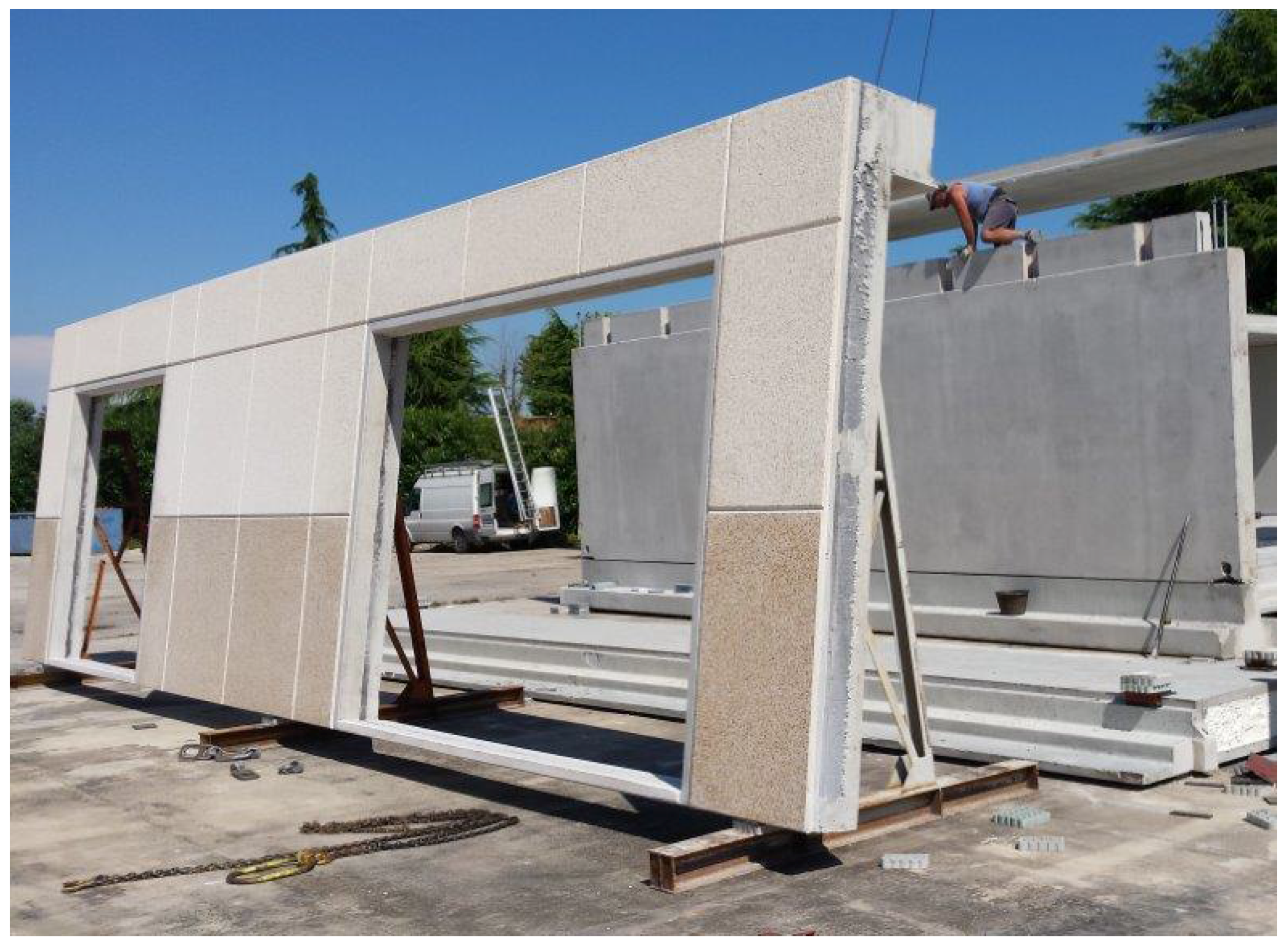
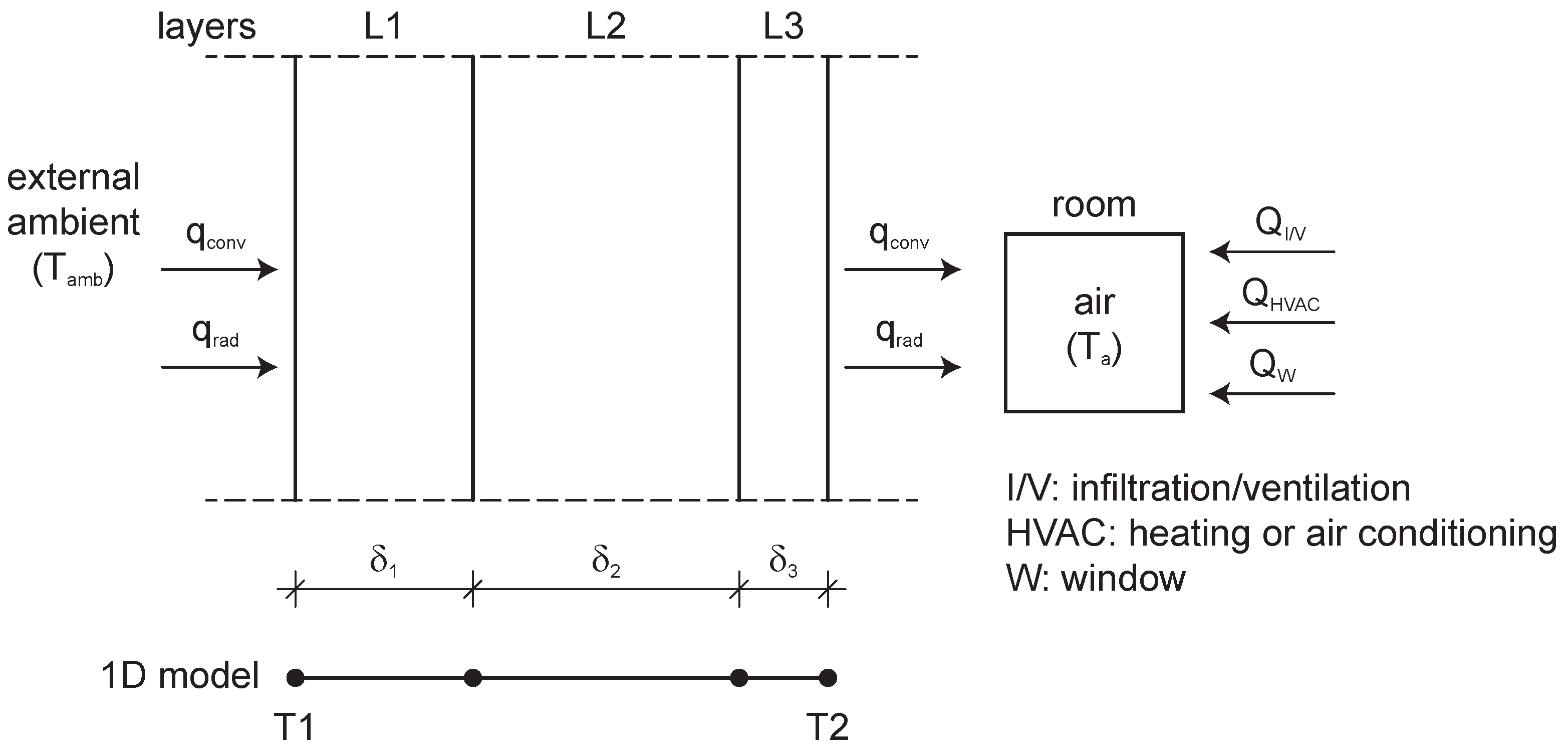
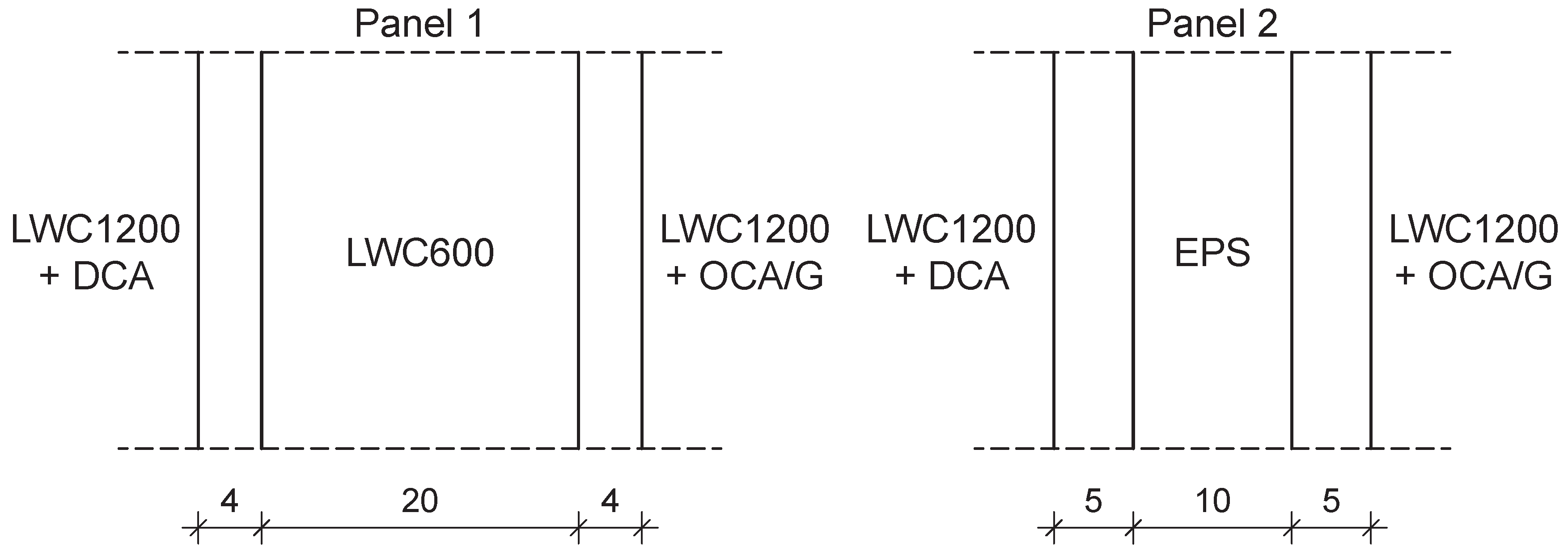
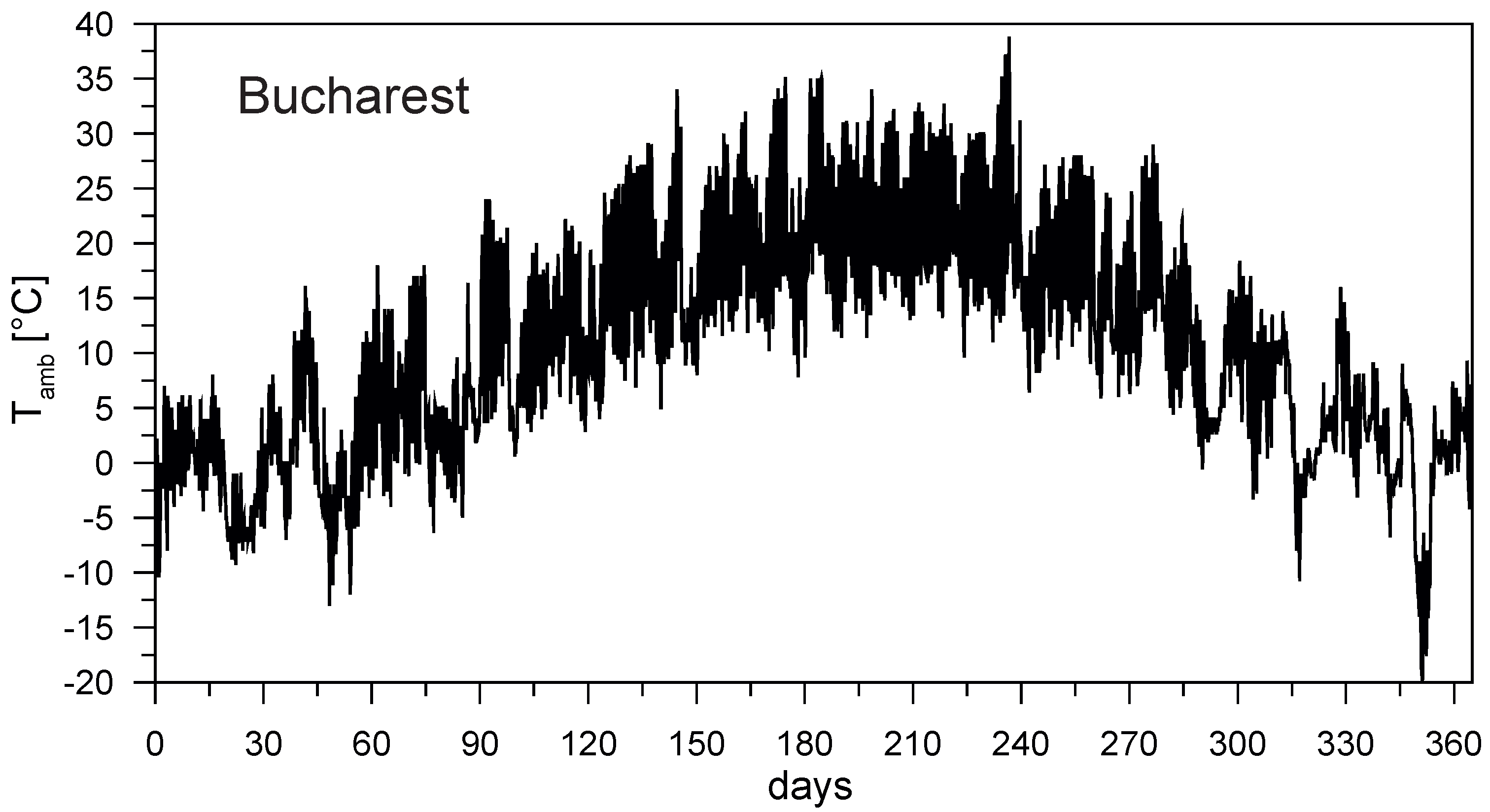
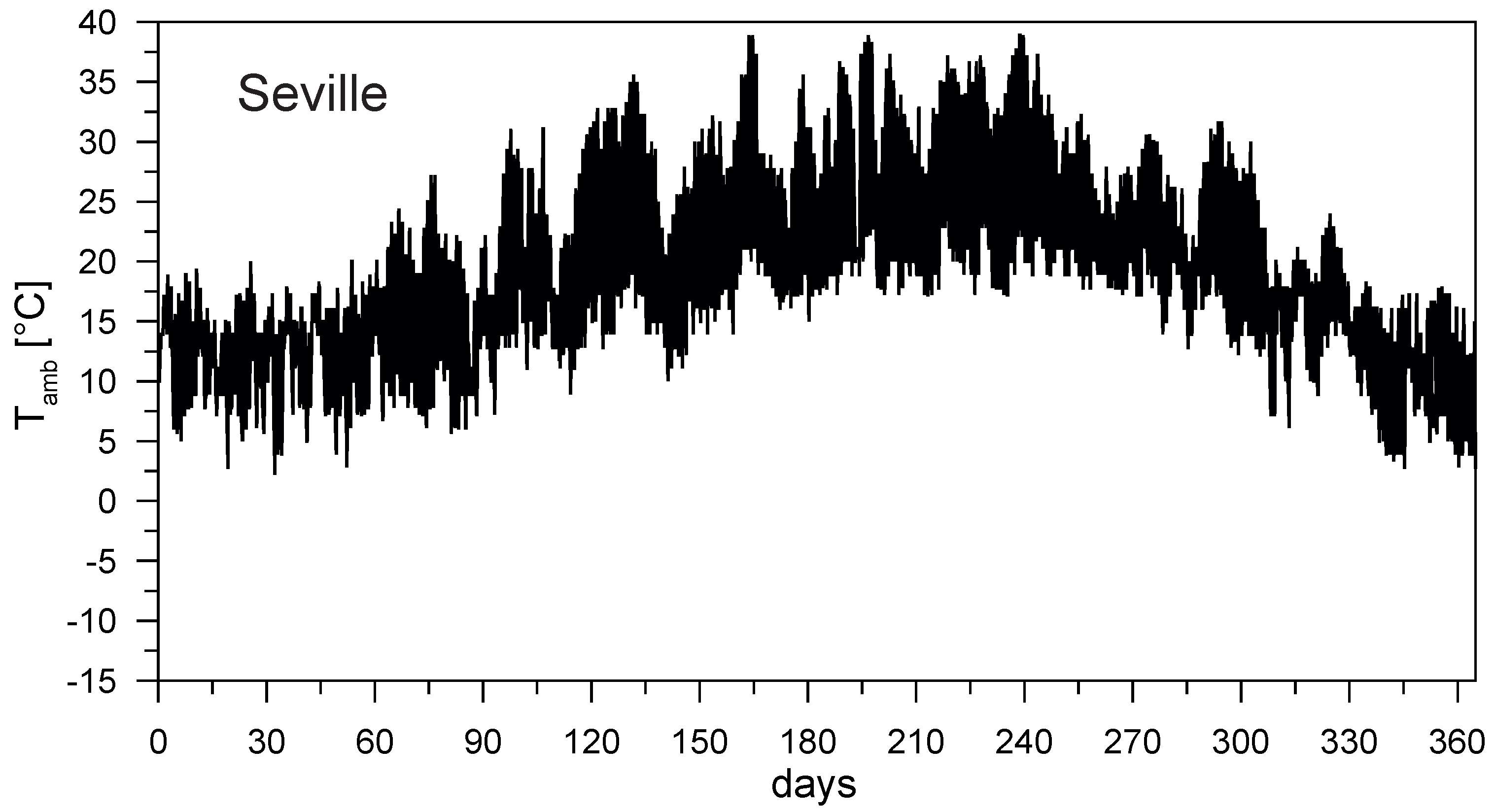
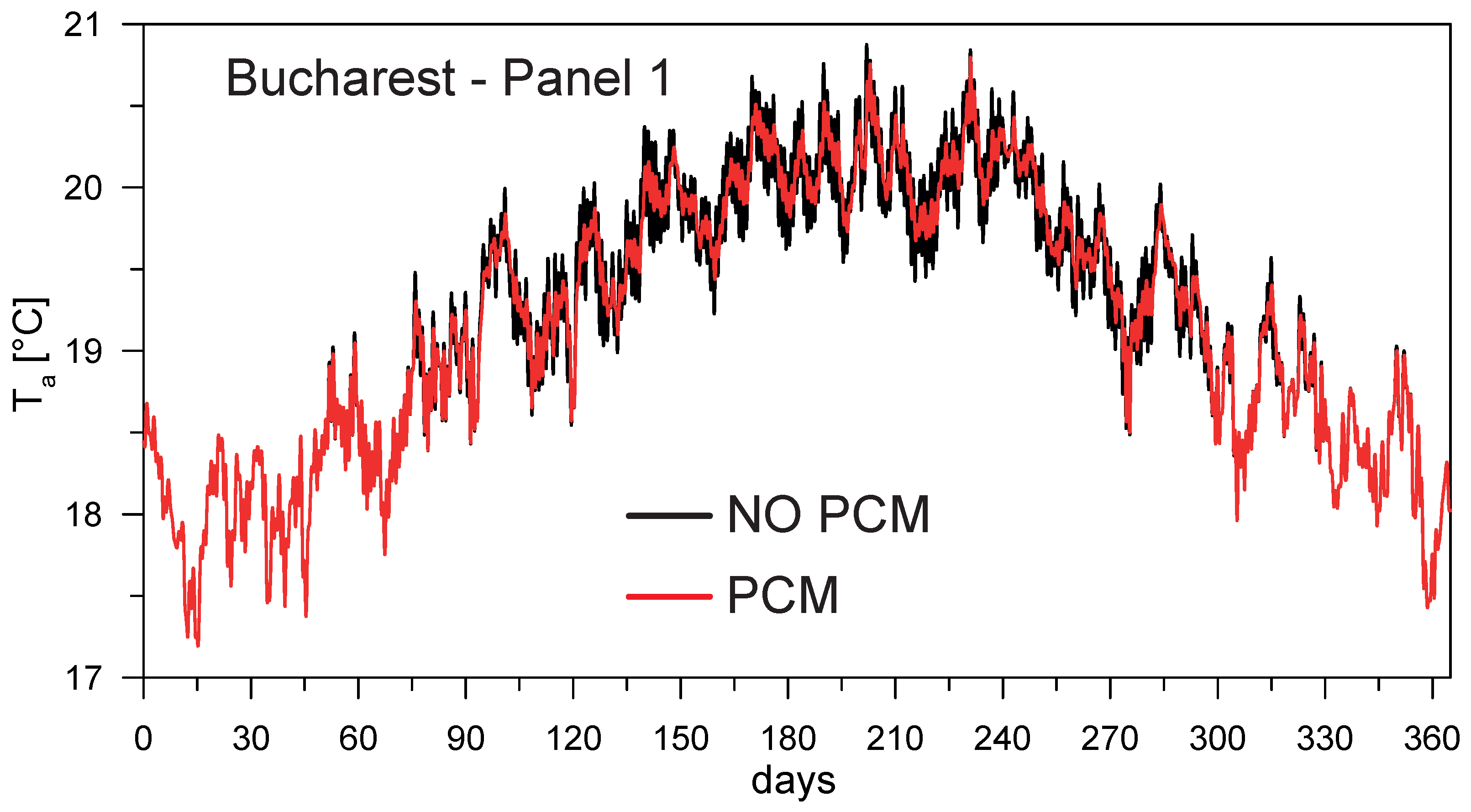
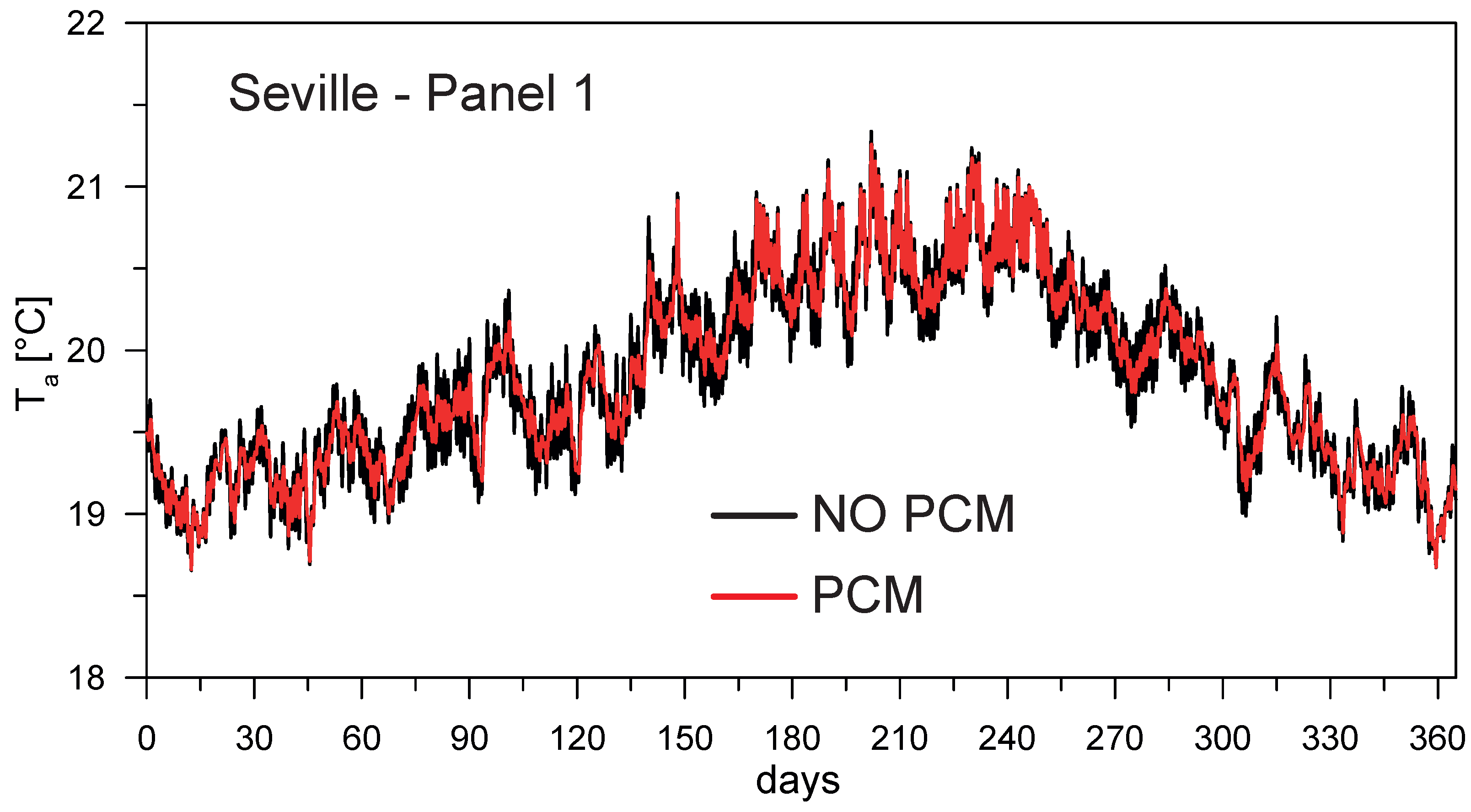
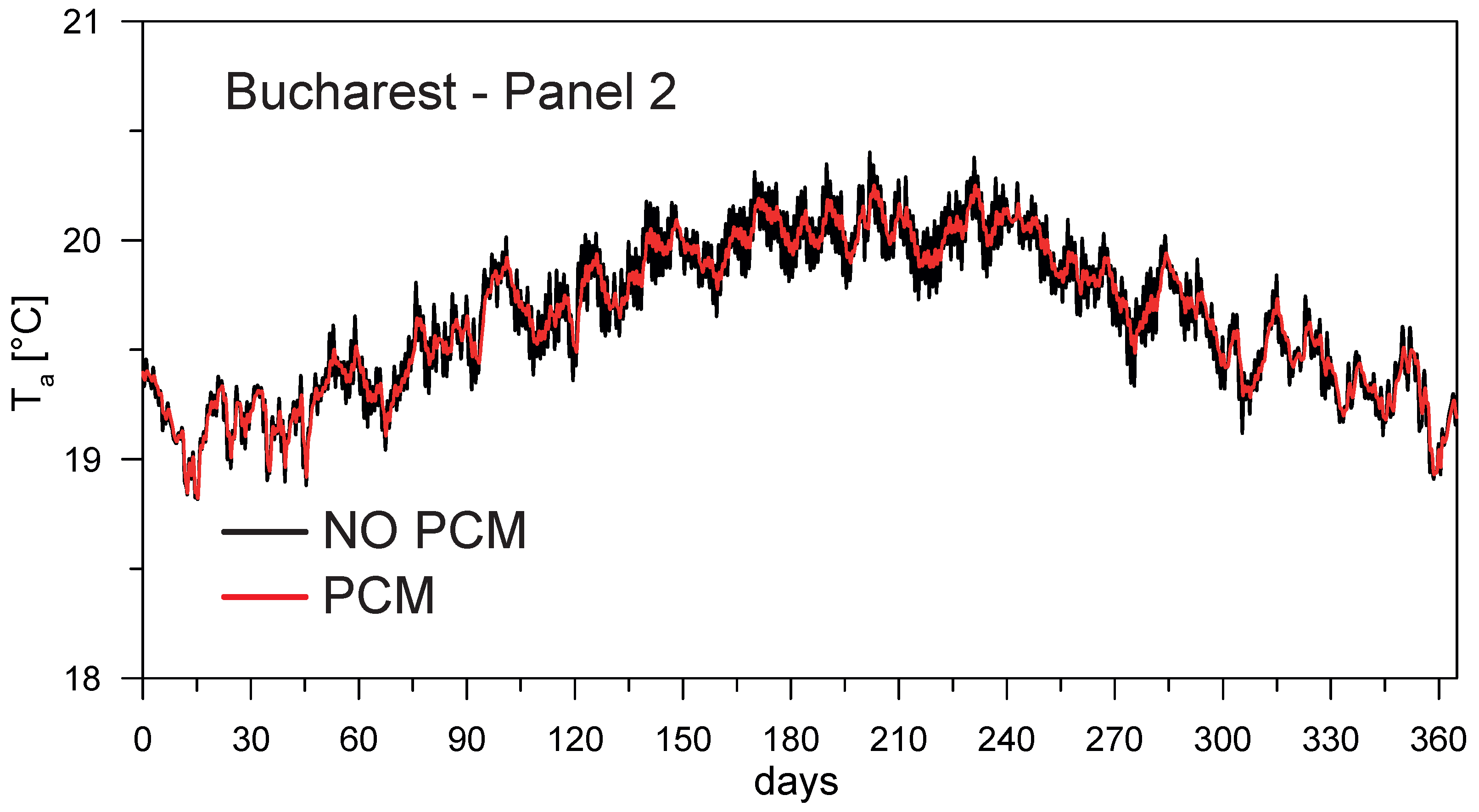
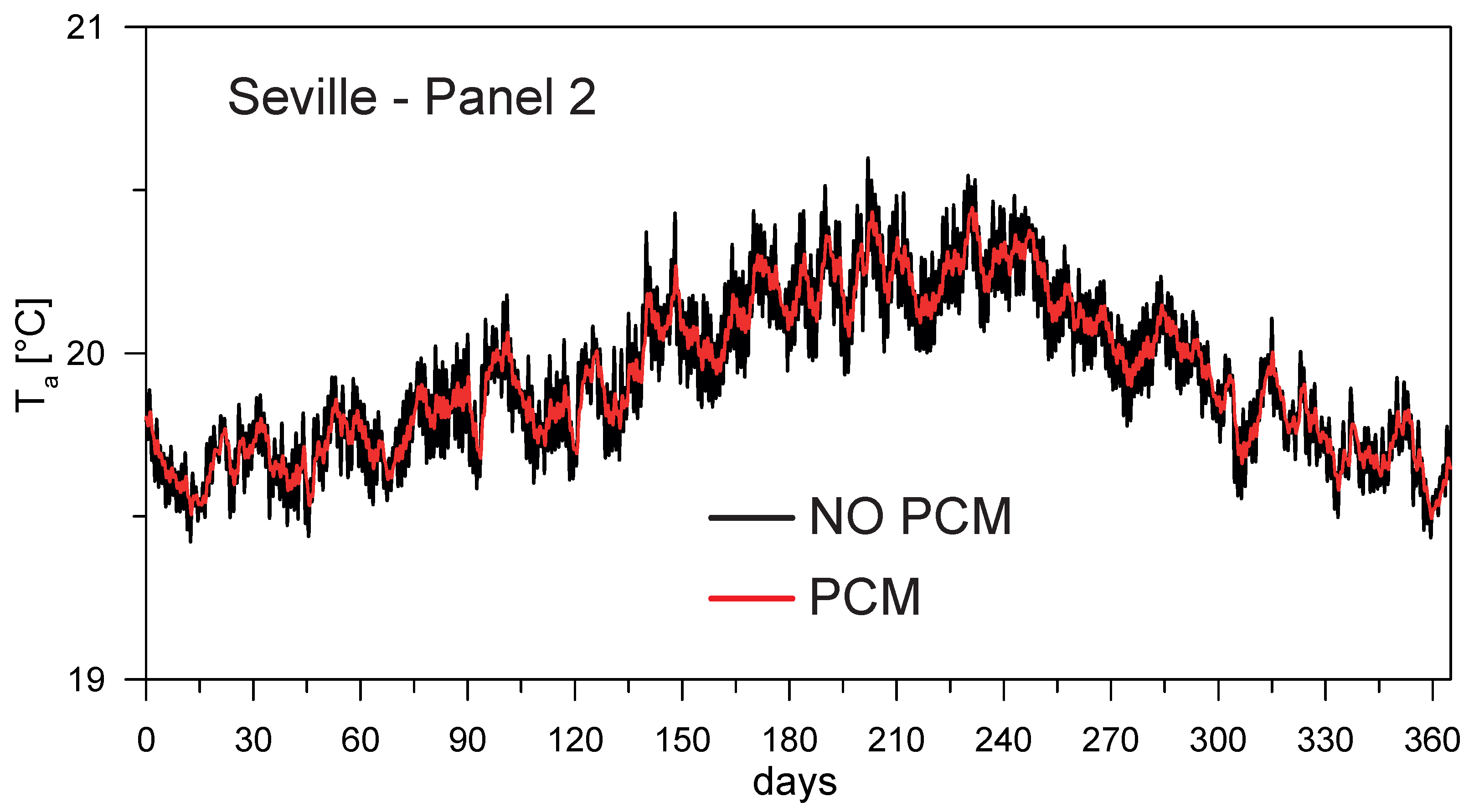
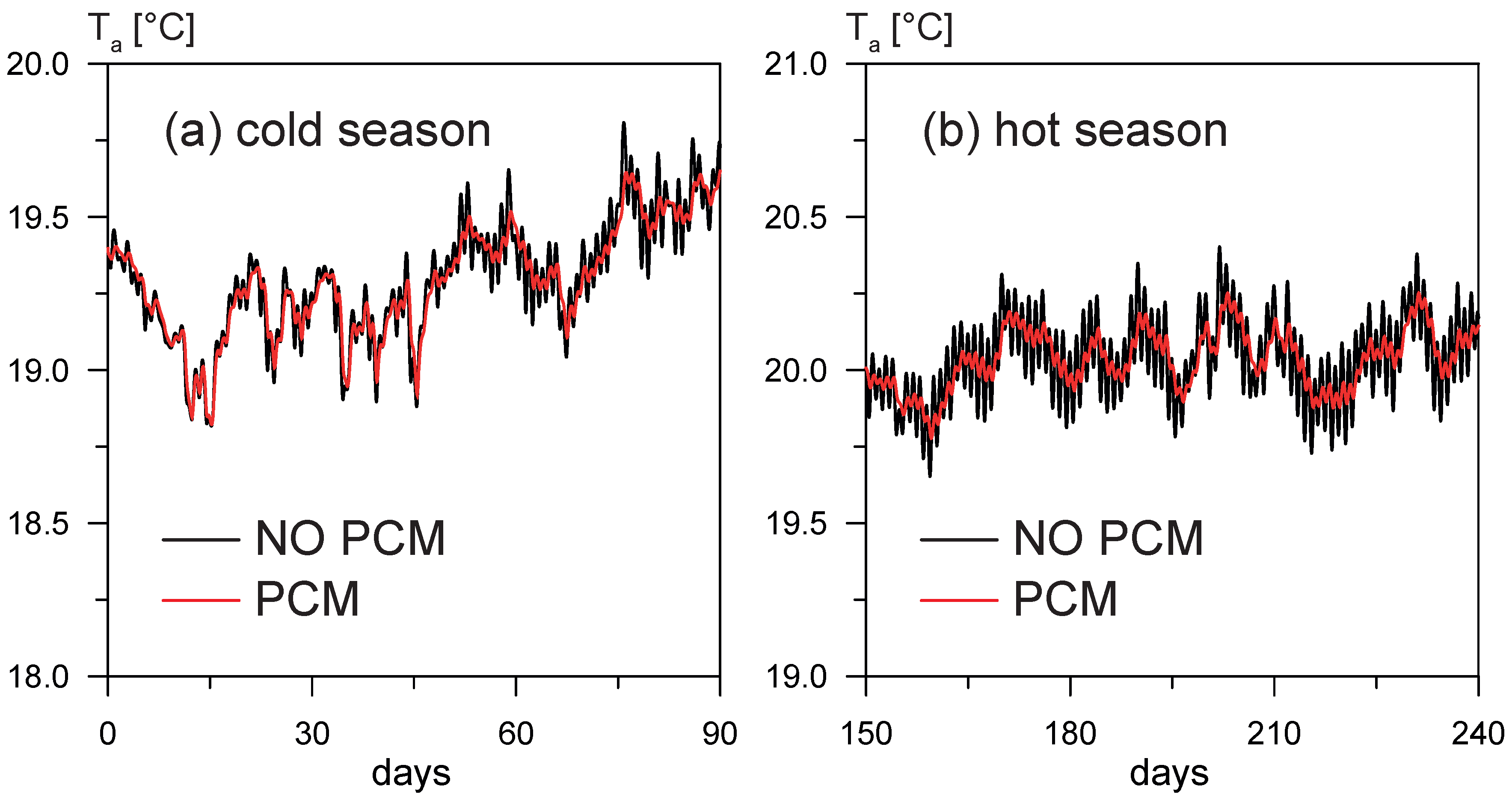
| Phase-Change Materials | Melt. Point | Latent Heat | Price | |||
|---|---|---|---|---|---|---|
| (°C) | (kJ/kg) | ($/kg) | (c$/kJ) | |||
| Paraffins | Hexadecane | 18.2 | 237 | 2.00 | 0.84 | |
| Octadecane | 29.0 | 244 | 1.87 | 0.77 | ||
| Fatty Acids | Caprylic acid (octanoic) | 16.7 | 149 | 11.1 | 7.47 | |
| Capric acid (decanoic) | 31.6 | 152 | 10.1 | 7.32 | ||
| Lauric acid (dodecanoic) | 43.8 | 178 | 9.70 | 5.67 | ||
| Polyols | Glycerine | 17.9 | 199 | 0.12 | 0.06 | |
| Material | Density | Conductivity | Specific Heat |
|---|---|---|---|
| (kg/m3) | (W/(m·°C)) | (J/kg) | |
| NSC | 2400 | 1.64 | 1000 |
| Insulation | 200 | 0.035 | 1500 |
| LWC600 | 600 | 0.2 | 840 |
| LWC1200 | 1200 | 0.4 | 840 |
| Material | Density | Conductivity | Specific Heat | Melting Temperature | Latent Heat |
|---|---|---|---|---|---|
| (kg/m3) | (W/(m·°C)) | (J/kg) | (C) | (kJ/kg) | |
| Capric acid (octanoic) | 900 | 0.35 | 1950–2110 | 16.7 | 149 |
| Capric acid (decanoic) | 900 | 0.35 | 2090 | 31.6 | 152 |
| Glycerine | - | - | - | 17.9 | 199 |
| Material | Density | PCM Mass Fraction | Melting Temperature | Latent Heat |
|---|---|---|---|---|
| (kg/m3) | (%) | (°C) | (J/kg) | |
| LWC1200 + OCA/G | 1440 | 9–11 | 19.7 | 13500 |
| LWC1200 + DCA | 1440 | 9–11 | 31.6 | 13500 |
| Panel | Buc-Qin | Buc-Qout | Sev-Qin | Sev-Qout |
|---|---|---|---|---|
| 1 (with PCM) | 6.62 | 23.29 | 10.45 | 11.11 |
| 1 (w/o PCM) | 7.26 | 23.29 | 11.11 | 11.17 |
| 2 (with PCM) | 2.08 | 9.77 | 3.70 | 4.20 |
| 2 (w/o PCM) | 3.34 | 9.82 | 4.97 | 4.80 |
| Panel | Buc-Ein | Buc-Eout | Sev-Ein | Sev-Eout |
|---|---|---|---|---|
| 1 (with PCM) | 3.09 | 63.02 | 12.41 | 23.91 |
| 1 (w/o PCM) | 3.61 | 63.53 | 12.83 | 24.36 |
| 2 (with PCM) | 1.27 | 26.40 | 5.19 | 10.01 |
| 2 (w/o PCM) | 1.61 | 26.76 | 5.47 | 10.32 |
© 2017 by the authors. Licensee MDPI, Basel, Switzerland. This article is an open access article distributed under the terms and conditions of the Creative Commons Attribution (CC BY) license (http://creativecommons.org/licenses/by/4.0/).
Share and Cite
Bamonte, P.; Caverzan, A.; Kalaba, N.; Lamperti Tornaghi, M. Lightweight Concrete Containing Phase Change Materials (PCMs): A Numerical Investigation on the Thermal Behaviour of Cladding Panels. Buildings 2017, 7, 35. https://doi.org/10.3390/buildings7020035
Bamonte P, Caverzan A, Kalaba N, Lamperti Tornaghi M. Lightweight Concrete Containing Phase Change Materials (PCMs): A Numerical Investigation on the Thermal Behaviour of Cladding Panels. Buildings. 2017; 7(2):35. https://doi.org/10.3390/buildings7020035
Chicago/Turabian StyleBamonte, Patrick, Alessio Caverzan, Nataša Kalaba, and Marco Lamperti Tornaghi. 2017. "Lightweight Concrete Containing Phase Change Materials (PCMs): A Numerical Investigation on the Thermal Behaviour of Cladding Panels" Buildings 7, no. 2: 35. https://doi.org/10.3390/buildings7020035






